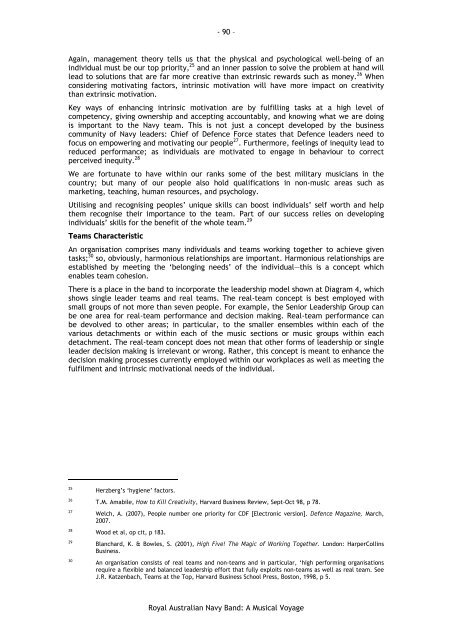A MUSICAL VOYAGE - Royal Australian Navy
A MUSICAL VOYAGE - Royal Australian Navy
A MUSICAL VOYAGE - Royal Australian Navy
You also want an ePaper? Increase the reach of your titles
YUMPU automatically turns print PDFs into web optimized ePapers that Google loves.
- 90 –<br />
Again, management theory tells us that the physical and psychological well-being of an<br />
individual must be our top priority, 25 and an inner passion to solve the problem at hand will<br />
lead to solutions that are far more creative than extrinsic rewards such as money. 26 When<br />
considering motivating factors, intrinsic motivation will have more impact on creativity<br />
than extrinsic motivation.<br />
Key ways of enhancing intrinsic motivation are by fulfilling tasks at a high level of<br />
competency, giving ownership and accepting accountably, and knowing what we are doing<br />
is important to the <strong>Navy</strong> team. This is not just a concept developed by the business<br />
community of <strong>Navy</strong> leaders: Chief of Defence Force states that Defence leaders need to<br />
focus on empowering and motivating our people 27 . Furthermore, feelings of inequity lead to<br />
reduced performance; as individuals are motivated to engage in behaviour to correct<br />
perceived inequity. 28<br />
We are fortunate to have within our ranks some of the best military musicians in the<br />
country; but many of our people also hold qualifications in non-music areas such as<br />
marketing, teaching, human resources, and psychology.<br />
Utilising and recognising peoples’ unique skills can boost individuals’ self worth and help<br />
them recognise their importance to the team. Part of our success relies on developing<br />
individuals’ skills for the benefit of the whole team. 29<br />
Teams Characteristic<br />
An organisation comprises many individuals and teams working together to achieve given<br />
tasks; 30 so, obviously, harmonious relationships are important. Harmonious relationships are<br />
established by meeting the ‘belonging needs’ of the individual—this is a concept which<br />
enables team cohesion.<br />
There is a place in the band to incorporate the leadership model shown at Diagram 4, which<br />
shows single leader teams and real teams. The real-team concept is best employed with<br />
small groups of not more than seven people. For example, the Senior Leadership Group can<br />
be one area for real-team performance and decision making. Real-team performance can<br />
be devolved to other areas; in particular, to the smaller ensembles within each of the<br />
various detachments or within each of the music sections or music groups within each<br />
detachment. The real-team concept does not mean that other forms of leadership or single<br />
leader decision making is irrelevant or wrong. Rather, this concept is meant to enhance the<br />
decision making processes currently employed within our workplaces as well as meeting the<br />
fulfilment and intrinsic motivational needs of the individual.<br />
25 Herzberg’s ‘hygiene’ factors.<br />
26 T.M. Amabile, How to Kill Creativity, Harvard Business Review, Sept-Oct 98, p 78.<br />
27 Welch, A. (2007), People number one priority for CDF [Electronic version]. Defence Magazine, March,<br />
2007.<br />
28 Wood et al, op cit, p 183.<br />
29 Blanchard, K. & Bowles, S. (2001), High Five! The Magic of Working Together. London: HarperCollins<br />
Business.<br />
30 An organisation consists of real teams and non-teams and in particular, ‘high performing organisations<br />
require a flexible and balanced leadership effort that fully exploits non-teams as well as real team. See<br />
J.R. Katzenbach, Teams at the Top, Harvard Business School Press, Boston, 1998, p 5.<br />
<strong>Royal</strong> <strong>Australian</strong> <strong>Navy</strong> Band: A Musical Voyage

















